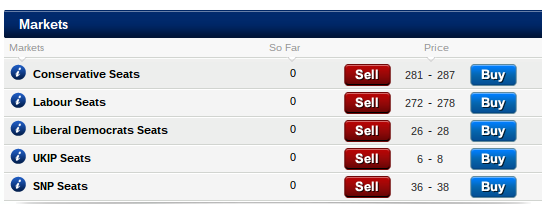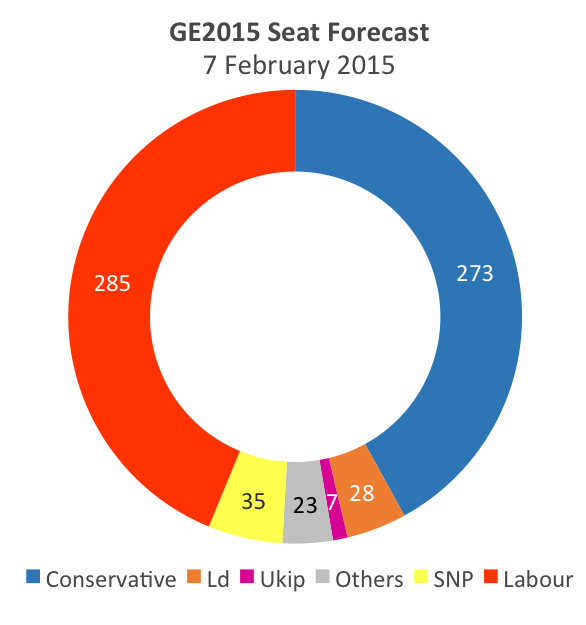Prompted by politicalbetting poster Pulpstar, I've been looking at the seat band markets today. These are not markets I usually like playing, because there are usually substantial overrounds and the bands are usually fairly narrow. But I've noticed something a bit odd about these markets. To understand what's odd, I need to start elsewhere.
Here are the current spreads on Sporting Index's seat markets:
The mid-points do not differ markedly from the assumptions in the over/under seat markets on the conventional bookies. I haven't recently updated my list of assumed seat winners from the constituency markets at best prices, but Lord Ashcroft put this up on twitter today and I have no reason to doubt its accuracy:
Anyway, my point is this. Whichever market you look at, the Conservatives and Labour are currently expected to get something of the order of 550 to 560 seats between them. This is not a zero sum game, because either could do better or worse against UKIP, the Lib Dems or the SNP than is currently anticipated, but assuming this share of seats as a starting point seems reasonable enough.
If we look at the seat band markets, however, we get a different picture. Here are the current best prices:
201-225 25/1 (Ladbrokes)
226-250 16/1 (Ladbrokes)
251-275 7/2 (Ladbrokes, SkyBet)
276-300 15/8 (SkyBet)
301-325 11/4 (Ladbrokes, SkyBet)
326-350 7/1 (SkyBet)
351-375 16/1 (Ladbrokes, SkyBet)
376-400 25/1 (Ladbrokes, SkyBet)
401+ 50/1 (Ladbrokes, SkyBet)
201-225 20/1 (Ladbrokes, SkyBet)
226-250 12/1 (Ladbrokes)
251-275 11/4 (William Hill)
276-300 15/8 (Ladbrokes, William Hill, SkyBet)
301-325 3/1 (Ladbrokes, William Hill, SkyBet)
326-350 8/1 (Ladbrokes)
351-375 33/1 (Ladbrokes)
376-400 50/1 (Ladbrokes)
401+ 66/1 (SkyBet)
The pivot on these markets seems to be something closer to 570 seats shared between Labour and the Conservatives, or maybe a little higher. But with the rise of the SNP, that looks about a minimum of 10 seats too high. Note that chart published by Lord Ashcroft - the SNP are expected to take 35 seats. Yet that still lags a bit behind the preponderance of the polling of the last few months.
The pricing gets odder when you go outside that band. If Labour are getting 301-325 seats, the chances are that the Conservatives are getting somewhere around 250 seats. But while Labour getting 301-325 seats is a 3/1 shot and getting 326-350 is an 8/1 shot, you can get 16/1 on the Conservatives getting 226-250. Something is wrong somewhere in the pricing there.
Clearly it's possible for Labour to get c305 seats and the Conservatives to get c255 seats, taking the Conservatives outside the 226-250 band. But c245 seats for the Conservatives is also perfectly possible on a seat tally for Labour of c305 seats. And if Labour are in this band, they might be getting 315 to 320 seats. In those circumstances, you would definitely expect the Conservatives to be in the 226-250 seat band.
You can make the prices for the Labour 301-325 band and the Conservative 226-250 band work if you take the view that Labour will probably get into the 301-325 band only if they claw back some of their current losses from the SNP (that doesn't explain the short price for 326-350 seats, but I'll leave that be). That's an entirely valid way of looking at the position, though I don't share that view.
But that doesn't really explain the reverse - you can get 11/4 on the Conservatives getting 301-325 seats, but 12/1 on Labour getting 226-250 seats. You can imagine Labour doing relatively better against the SNP than against the Conservatives as a matter of theory, but as a matter of practicality, it sounds unlikely. It's just as possible that the SNP could do better against Labour than currently expected, making 226-250 more likely if the Conservatives outperform.
What are the odds in practice that either Labour or the Conservatives will get more than 300 seats? For Labour, there are two routes from the current position: to win more seats from the Conservatives than is currently expected or to hold onto more from the SNP than is currently expected (a bit of both is allowed, of course). For the Conservatives, there's only really one route: to win seats more from Labour than is currently expected (though they are allowed to pick up more than currently expected from UKIP and the Lib Dems, these are unlikely to get them to the 300 seat mark by themselves).
In both cases, it has to be odds against, but it's not out of the question, and most of those possibilities in both cases will be concentrated in the 301-325 band.
With that in mind, backing Labour at 12/1 in 226-250 and the Conservatives at 16/1 in 226-250 both seem like good bets to me as proxies for the possibility of either Conservative or Labour outperformance against current market expectations. Clearly both are odds against bets. But the combined probability of 13/2 looks too low to me - they're probably twice as long as they should be. I'm on both.
And more generally, if you insist on playing the Labour and Conservative seat bands, I suggest that you go low on the opposite party. It seems to offer better value.
Anyway, my point is this. Whichever market you look at, the Conservatives and Labour are currently expected to get something of the order of 550 to 560 seats between them. This is not a zero sum game, because either could do better or worse against UKIP, the Lib Dems or the SNP than is currently anticipated, but assuming this share of seats as a starting point seems reasonable enough.
If we look at the seat band markets, however, we get a different picture. Here are the current best prices:
Con
0-200 50/1 (Ladbrokes)201-225 25/1 (Ladbrokes)
226-250 16/1 (Ladbrokes)
251-275 7/2 (Ladbrokes, SkyBet)
276-300 15/8 (SkyBet)
301-325 11/4 (Ladbrokes, SkyBet)
326-350 7/1 (SkyBet)
351-375 16/1 (Ladbrokes, SkyBet)
376-400 25/1 (Ladbrokes, SkyBet)
401+ 50/1 (Ladbrokes, SkyBet)
351+ 8/1 (William Hill)
Lab
0-200 33/1 (Ladbrokes, SkyBet)201-225 20/1 (Ladbrokes, SkyBet)
226-250 12/1 (Ladbrokes)
251-275 11/4 (William Hill)
276-300 15/8 (Ladbrokes, William Hill, SkyBet)
301-325 3/1 (Ladbrokes, William Hill, SkyBet)
326-350 8/1 (Ladbrokes)
351-375 33/1 (Ladbrokes)
376-400 50/1 (Ladbrokes)
401+ 66/1 (SkyBet)
351+ 7/1 (William Hill)
The pivot is not around the 550-560 seats that every other market assumes. For starters, the favourite for both is 276-300. That's possible if they share 560 seats, but only if both are at the bottom end of that band. That really is like landing on a pinhead. More likely, one would get in that band and one would get in the 251-275 band.The pivot on these markets seems to be something closer to 570 seats shared between Labour and the Conservatives, or maybe a little higher. But with the rise of the SNP, that looks about a minimum of 10 seats too high. Note that chart published by Lord Ashcroft - the SNP are expected to take 35 seats. Yet that still lags a bit behind the preponderance of the polling of the last few months.
The pricing gets odder when you go outside that band. If Labour are getting 301-325 seats, the chances are that the Conservatives are getting somewhere around 250 seats. But while Labour getting 301-325 seats is a 3/1 shot and getting 326-350 is an 8/1 shot, you can get 16/1 on the Conservatives getting 226-250. Something is wrong somewhere in the pricing there.
Clearly it's possible for Labour to get c305 seats and the Conservatives to get c255 seats, taking the Conservatives outside the 226-250 band. But c245 seats for the Conservatives is also perfectly possible on a seat tally for Labour of c305 seats. And if Labour are in this band, they might be getting 315 to 320 seats. In those circumstances, you would definitely expect the Conservatives to be in the 226-250 seat band.
You can make the prices for the Labour 301-325 band and the Conservative 226-250 band work if you take the view that Labour will probably get into the 301-325 band only if they claw back some of their current losses from the SNP (that doesn't explain the short price for 326-350 seats, but I'll leave that be). That's an entirely valid way of looking at the position, though I don't share that view.
But that doesn't really explain the reverse - you can get 11/4 on the Conservatives getting 301-325 seats, but 12/1 on Labour getting 226-250 seats. You can imagine Labour doing relatively better against the SNP than against the Conservatives as a matter of theory, but as a matter of practicality, it sounds unlikely. It's just as possible that the SNP could do better against Labour than currently expected, making 226-250 more likely if the Conservatives outperform.
What are the odds in practice that either Labour or the Conservatives will get more than 300 seats? For Labour, there are two routes from the current position: to win more seats from the Conservatives than is currently expected or to hold onto more from the SNP than is currently expected (a bit of both is allowed, of course). For the Conservatives, there's only really one route: to win seats more from Labour than is currently expected (though they are allowed to pick up more than currently expected from UKIP and the Lib Dems, these are unlikely to get them to the 300 seat mark by themselves).
In both cases, it has to be odds against, but it's not out of the question, and most of those possibilities in both cases will be concentrated in the 301-325 band.
With that in mind, backing Labour at 12/1 in 226-250 and the Conservatives at 16/1 in 226-250 both seem like good bets to me as proxies for the possibility of either Conservative or Labour outperformance against current market expectations. Clearly both are odds against bets. But the combined probability of 13/2 looks too low to me - they're probably twice as long as they should be. I'm on both.
And more generally, if you insist on playing the Labour and Conservative seat bands, I suggest that you go low on the opposite party. It seems to offer better value.



1 comment:
Pulpstar:
Ladbrokes have now halved their prices on these seat bands....
Nice work, got £20 on each of the bands at 12s and 16s.
Skybet's 10s 226-250 is still most likely value btw.
Post a Comment